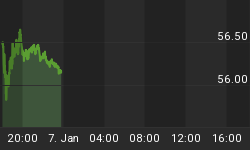It was another quiet day on Tuesday. The stock market opened with a gap up, but faded; bonds with a gap down, but covered that gap into the close. June T-Note futures closed 1/64th higher, with 10y yields unchanged at 3.61%.
The only economic datum was vehicle sales, which ended up approximately on-target thanks to an exceptional performance by Ford, which sold more vehicles than GM for the first time (but probably not the last!) in a very long time. Apparently, consumers are choosing private enterprise over Government Motors. Go figure! (Polls tell us the same thing is true when it comes to choosing health care, but some folks think they know better.)
Domestic car sales ended up at about 7.9mm units, essentially flat to consensus estimates and a continued recovery from very low levels seen pre-cash-for-clunkers last year (see Chart, source Bloomberg). It wasn't so long ago that 12mm units was considered a bad year, although it pays to remember that from about 2000 through 2006 car sales were kept artificially high through crazy dealer incentives. In those days, 0% financing for 5 or 7 years represented a 30-40% discount in the cost of a car to the consumer, and the fact that the auto majors couldn't wean themselves of such ridiculous discounts should have been a clear sign that the structure of the industry in the U.S. was unsustainable in the long run. (Of course, now 0% financing isn't a big deal, since all rates are about 0% anyway!)

Not so long ago, 12mm cars was a bad year (thanks to incentives).
On the day stocks added only 0.2%, but importantly the positive close was approximately at the low of the day after a gap above the "neckline" of the head and shoulders pattern I mentioned yesterday. I am not a big techie, but if the market can open positive on Wednesday then I would expect momentum to grow toward a test of the January highs. It's important to remember that this isn't a bull market lift-off we're talking about; it's 4-5% and I wouldn't expect anything beyond that, even if we get there.
On a quiet day I found myself musing about just how quiet it has been for a while after the gyrations of 2007, 2008, and part of 2009. Remember, even prior to the crisis the shape of the yield curve had been quite volatile (a neat dynamic illustration of the yield curve is available here); one of the early painful episodes in the financial crisis was the dramatic inversion of the yield curves in the U.S. and abroad, driven partly by the need to hedge billions of "non-inversion notes" that all tended to need hedging at about the same time.
In inflation-land, the curve was inverted as recently as the summer of 2007, when high near-term energy prices led people to expect that inflation would stay high for a couple of years and then decline to some long-term average. As the crisis hit, the 1y inflation swap collapsed from 3.83% in July of 2007 to -5.35% in mid-December 2008, before finally bouncing as people jumped on 8+% short-term real yields.
But since early 2009, the inflation curve has been remarkably stable. The chart below (Source: Bloomberg data) shows inflation swap curves (2y, 5y, 7y, 10y, 30y) on the first business day of the month from March 2008 to March 2009. The months aren't labeled, because the sequence isn't important. What is incredible is that the curve moves up, the curve moves down, but the moves have been almost in parallel for the period of a whole year.

Over the last year, the shape of the inflation curve has been amazingly consistent.
That is nothing short of amazing. Everybody agrees that inflation should rise in the future; what changes is the perception of from-what-level. I won't say anything about how to play that in inflation-space, but I will say that the expectation of low inflation evolving very gradually into acceptable and moderate inflation is a recipe for good equity market performance. It isn't clear how we could have an inflation curve much more supportive of equities than it is and has been since the stock market bottom last year.
It won't always be that way. Remember that.
Tomorrow, Employment-Week hype gets started with the release of the ADP figures (Consensus -20k vs -22k last month). Goldman Sachs points out that while their weather models suggest a 100k drag to Payrolls, the ADP doesn't seem to have any weather bias they can detect. Still, a weak figure will likely be written off to...er...global warming while a strong figure will probably provoke more relief given the recent skein of weak data.
Also out is the ISM Non-Manufacturing report (Consensus: 51.0 vs 50.5 last). The Non-Man ISM seemed like a good idea when they first split it out from the Manufacturing ISM, but now it doesn't seem like anyone cares very much.
With the positive technical situation in stocks and a built-in excuse for economic weakness, I'd prefer to play these numbers from the short (fixed-income) side, even though I don't really believe those excuses.















